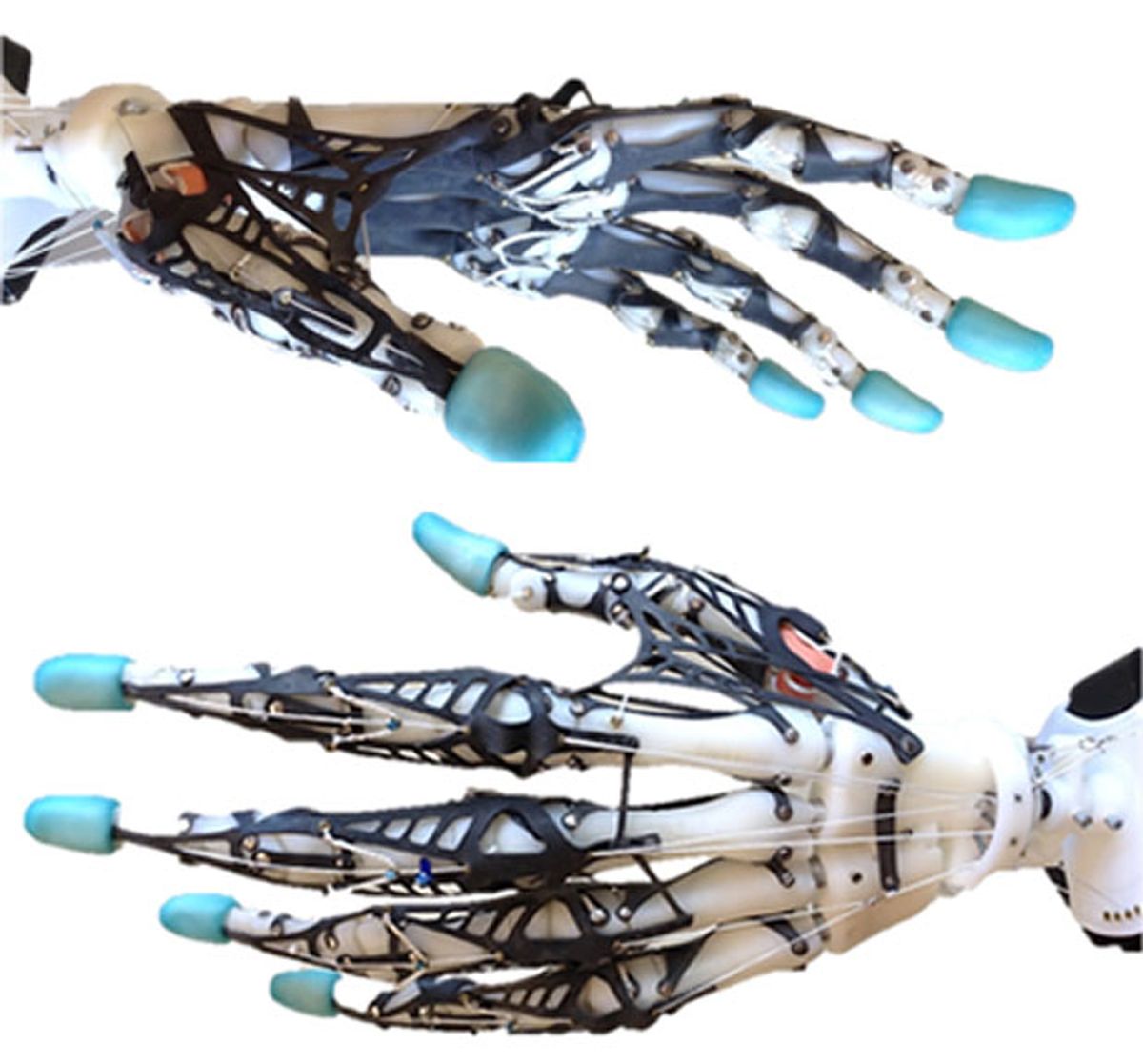There are two generalized schools of thought when it comes to robot hand design. You have robot hands that are simple and straightforward and get the job done, like two- or three-finger grippers that can reliably do many (if not most) things well without any fuss. And then you have very complex hands with four fingers and a thumb that are designed to closely mimic human hands, on the theory that human hands were intelligently designed by millions of years of evolution, and we’ve designed all of our stuff around them anyway, so if you want your robot to be able to do as many things as possible as well as possible you want a hand that’s as humanlike as possible.
Because of the inherent complexity of a real human hand, biomimetic anthropomorphic hands inevitably involve lots of compromises to get them to work properly while maintaining a human-ish form factor. Zhe Xu and Emanuel Todorov from the University of Washington, in Seattle, have gone crazy and built the most detailed and kinematically accurate biomimetic anthropomorphic robotic hand that we’ve ever seen, with the ultimate goal of replacing human hands completely.
Here’s why it was important for them to design a new kind of robotic hand, according to Xu:
“The conventional approach to designing anthropomorphic robotic hands often involves mechanizing biological parts with hinges, linkages, and gimbals in order to simplify the seemingly complicated human counterparts. This approach is helpful for understanding and approximating the kinematics of the human hand in general, but inevitably introduces undesirable discrepancies between the human and robotic hands since most of those salient biomechanical features of the human hand are discarded in the mechanizing process. The inherent mismatch between mechanisms of these robotic hands and biomechanics of human hands essentially prevents us from using natural hand motion to directly control them. Thus none of the existing anthropomorphic robotic hands can achieve the human-level dexterity yet.”
With their hand, Xu and Todorov decided to start from scratch, duplicating the human hand mechanically in as accurate a way as possible. First, they laser scanned a human skeleton hand, and then 3D-printed artificial bones to match, which allowed them to duplicate the unfixed joint axes that we have, as Xu explains:
“For example, the motion of our opposable thumb is relying on the complicated shape of the trapezium bone located at the carpometacarpal (CMC) joint. Due to the irregular shape of the trapezium bone, the exact locations of CMC joint axes are not fixed. Thus, none of the existing anthropomorphic robotic hands can restore the natural thumb motions with conventional mechanical joints that require fixed rotation axes. We 3D print artificial bones from the laser-scanned model of a cadaver skeleton hand and connect them with artificial finger joints whose range of motion, stiffness, and dynamic behaviors are very close to their human counterparts. Our robotic hand design uniquely preserves the important biomechanical information of the human hand on anatomical level.”
Joint ligaments (which stabilize joints and control their range of motion) are made of high strength Spectra strings, with laser-cut rubber sheets replacing the soft tissues that add joint compliance. Extensor and flexor tendons (for straightening and bending fingers) are also made of Spectra, with more laser-cut rubber sheets for the tendon sheathing and extensor hood, which is a complex webbed multi-layered structure that wraps around the fingers to help manage flexibility and torque. The final part to UW’s hand are the muscles, which are made up of an array of 10 Dynamixel servos, whose cable routing closely mimics the carpal tunnel of a human hand.
Besides being an extraordinarily beautiful piece of craftsmanship, the UW hand is able to very closely mimic a wide variety of grasps when controlled with a waldo remote manipulator. Users can also perform complicated in-hand manipulation without force feedback, which the researchers attribute to the kinematics of their hand so closely matching that of a real human hand.
This is really the key: the fact that the hand is designed to mimic a human hand means that it mimics a human hand in operation, due primarily to its construction rather than any kind of programming. This has lots of potential advantages in telemanipulation, since the operator can more seamlessly leverage the dexterity of their own hands.
What’s even more interesting is that the researchers suggest that their hand could be used “as 3D scaffolds for limb regeneration research,” as Xu explains:
“The control of prosthetic hands essentially relies on human brain. Therefore the same neuroprosthetic technologies could be more effective if the design of the prosthesis could be more similar to its biological counterpart. Biocompatible materials can now be printed to form bone structures, biodegradable artificial ligaments have been used to replace the torn anterior cruciate ligaments, human muscles have been successfully cultivated inside petri dish, and peripheral nerves can also be regenerated given the right conditions. All of the these promising technologies require suitable scaffolds for the growth of grafted cells. We are going to collaborate with researchers from biology and tissue engineering to further explore its potential to serve as a bio-fabricated device/scaffold in the emerging fields of neuroprosthetics and limb regeneration.”
“Design of a Highly Biomimetic Anthropomorphic Robotic Hand Towards Artificial Limb Regeneration,” by Zhe Xu and Emanuel Todorov from the University of Washington, will be presented at ICRA in Stockholm, Sweden, in May.
Zhe Xu is currently a postdoc at Yale University’s GRAB Lab.
Evan Ackerman is a senior editor at IEEE Spectrum. Since 2007, he has written over 6,000 articles on robotics and technology. He has a degree in Martian geology and is excellent at playing bagpipes.






